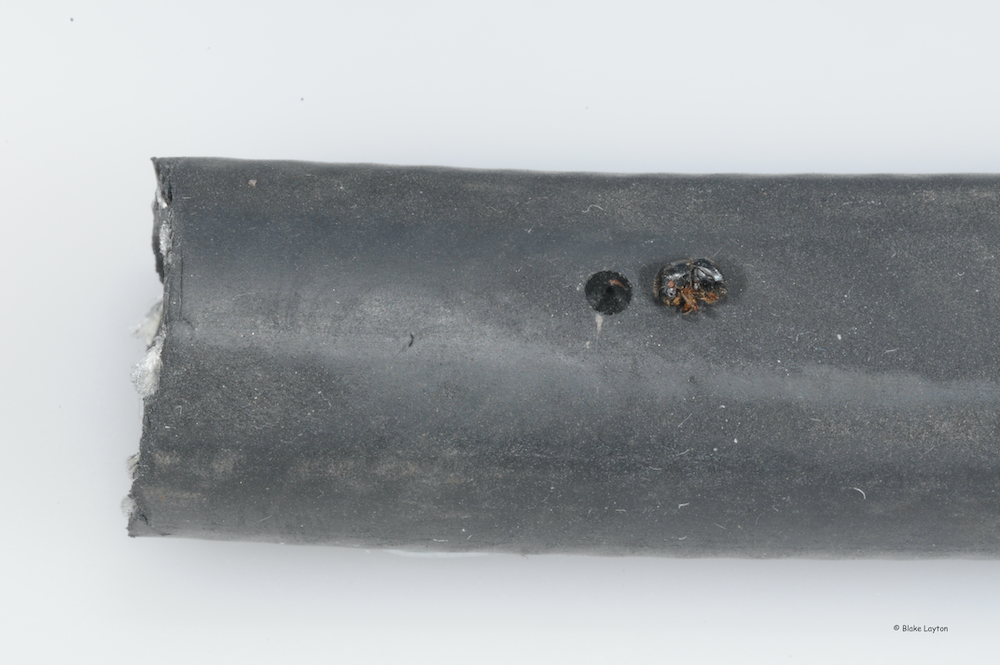Gas Can Beetle, Vol. 7, No. 7
Cnestus mutilatus.
Order: Coleoptera
Family: Curculionidae
It was time to spray some pastures. So, Mr. Joe got the spray rig hooked up, filled it with clean water, and turned it on so he could check that everything was working. He was pretty sure it would be because last fall he had taken the time to flush the system with an antifreeze solution to keep freezing water from cracking the pump or causing other damage. Had that happen the year before and, didn’t want any such problems this year. The pump was working fine. You could tell it was working because water was spewing from dozens of little round holes all along the spray hoses. What went wrong? What made all those holes in the hoses?
Camphor shot borer is a non-native bark beetle that was first detected in 1999 and now occurs throughout the eastern US. Terry Schiefer, curator of the MSU Insect Museum, found the first ones in his back yard in Starkville. What are the odds of that happening? Terry specializes in studying beetles, particularly bark beetles, so he was running traps to collect bark beetles.
These beetles damage hardwood trees by boring 2 mm diameter holes through the bark and into the sapwood and inoculating the tunnels with a fungus. They carry the seed-like spores in special pockets they have on their backs, called mycangia, and this fungus forms a dense, felt-like growth on the walls of the tunnels. The larvae hatch from eggs deposited in the tunnels and feed on this fungal growth. Bark beetles that grow fungus in this way are collectively known as ambrosia beetles.
So why are these beetles also known as “gas can beetles” and why had they bored holes in Mr. Joe’s spray hoses? Camphor shot borers love alcohol. They can smell it from far away and are strongly attracted to it. They prefer to lay their eggs in weak or injured trees and such trees produce small amounts of alcohol. Out in the woods female shot borers find suitable hosts by flying to the odor of alcohol.
Trouble was, Mr. Joe used an ethanol-based antifreeze when he winterized that sprayer, and the ethanol was absorbed into the rubber hoses. This tricked female beetles that emerged in the spring and were looking for a tree in which to lay their eggs into boring into those rubber hoses instead.
This is not the only thing that tricks these beetles. Plastic gas cans or gas tanks filled with ethanol-containing gasoline are also attacked. Often the beetles don’t stop boring until they get a face full of gasoline. That stops them in their tracks! There may be more than a few beetles involved in these attacks. Some gas cans are so heavily riddled, they look like they have been blasted with heavy bird shot. Each year now there are cases of gas cans that leak, mowers that won’t run and sprayers that won’t spray because of “gas can beetles.” There have even been a few cases of sea-going boats being stranded miles offshore.
What does Terry use as bait for his bark beetle traps? Ethanol.
Blake Layton, Extension Entomology Specialist, Mississippi State University Extension Service.
The information given here is for educational purposes only. Always read and follow current label directions. Specific commercial products are mentioned as examples only and reference to specific products or trade names is made with the understanding that no discrimination is intended to other products that may also be suitable and appropriately labeled.
Mississippi State University is an equal opportunity institution.
Bug’s Eye View is now on Facebook. Join the Bug's Eye View Facebook group here.


